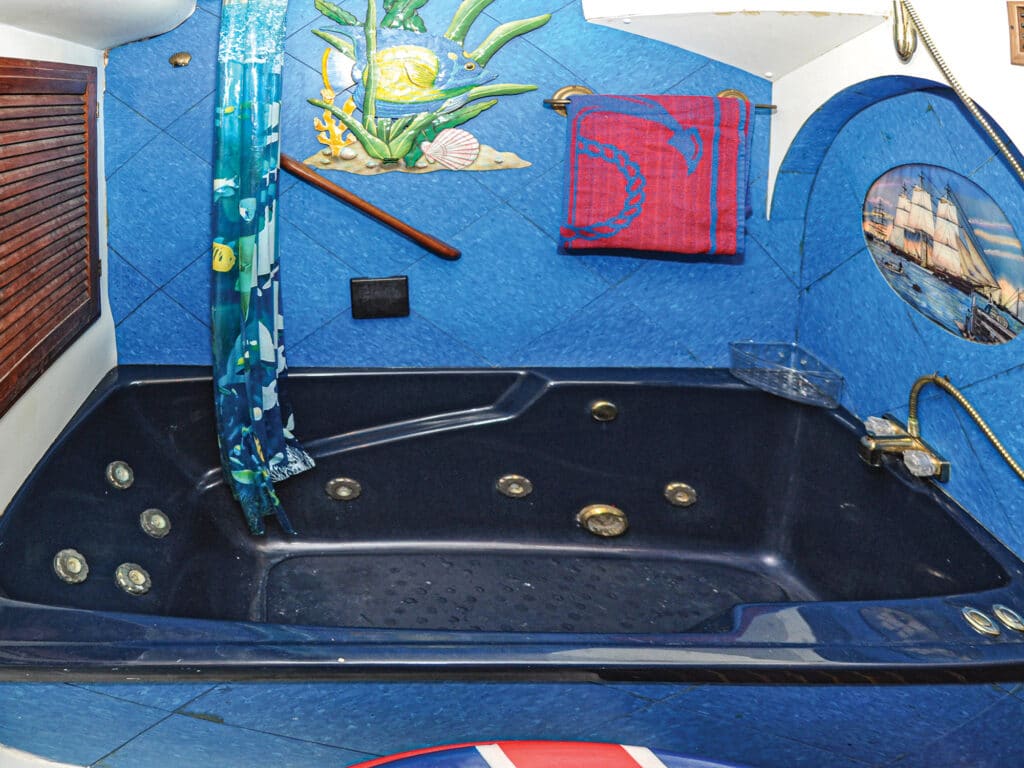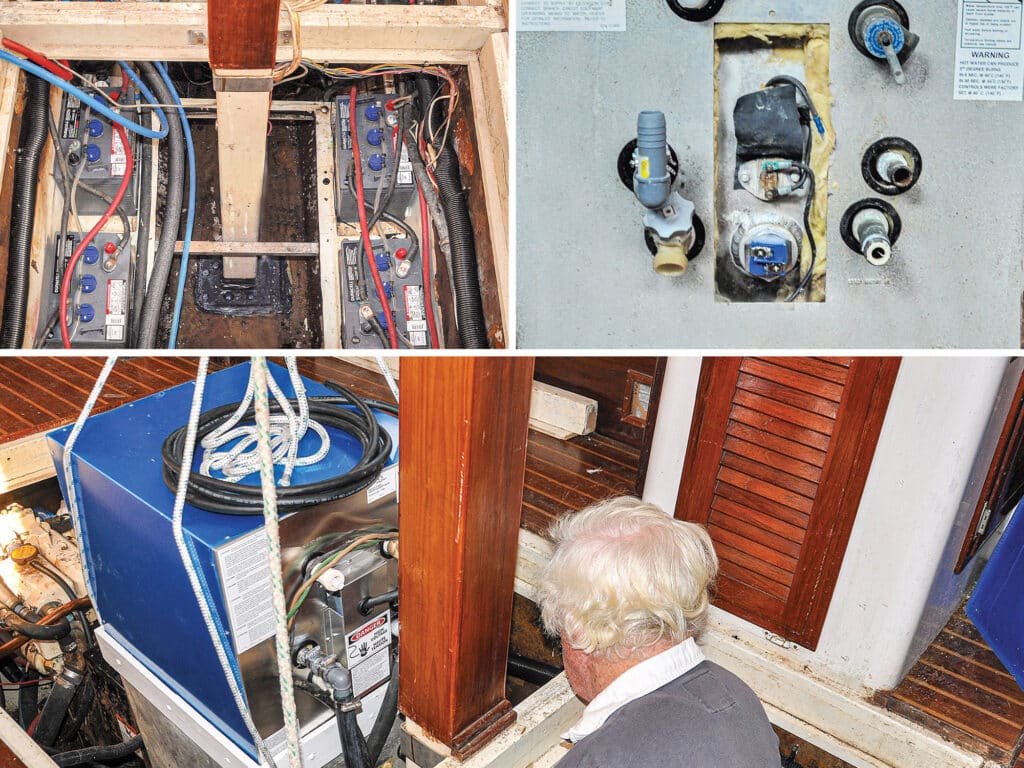
With 345 gallons of fresh water, my 50-foot schooner, Britannia, has larger-than-average tankage. The boat has two heads, each with a washbasin and shower, and a pressure pump as powerful as a house supply. Unfortunately, with only an 11-gallon hot-water tank, my hot water runs out quickly, especially if both showers are used at the same time. And if the hot runs out, you’re on your own, so to speak.
Britannia’s hot-water tank is the square Kuuma model, sold by just about everyone in the marine-supply business. Eleven gallons might sound like a lot to boats that have the smaller, 6-gallon version, but neither delivers its full capacity of hot water to a shower or sink faucet. This is because as the hot is drawn off, it is replaced with cold (ambient) from the boat’s tankage. This process dilutes the remaining hot, so by the time about half of the hot is used up, the rest is somewhat lukewarm. Of course, it helps to leave the electric element on, and even to run the engine to compensate for this loss, but that might not be practical every time.
This problem was exposed recently when we had four guests staying aboard who were new to boating. I had to explain (tactfully, of course) that they were on a boat, not in a house, and the hot water wouldn’t run endlessly. I suggested that only one morning shower should be taken at a time; otherwise, there would be a good chance of someone finishing with a cold rinse. It was embarrassing for me to have to admit that, even though my schooner has just about everything that a house has—a washer/dryer, freezer, fridge, air conditioning, 120-volt power in all rooms—it is woefully lacking in hot-water capacity. I therefore decided to look into rectifying the deficiency.
Another reason I wanted to increase the hot-water capacity was more personal. Britannia has a full-size bathtub in the aft cabin head. Many boats of Britannia’s size have bathtubs, but mine is not just any old tub; it has 10 power jets, making it a hot tub. The idea is to fill the bath with hot water now and again for a long soak. I actually consider this to be more important than the shower issue, because how many times do we have guests staying over and wanting dual morning showers compared with me enjoying a British pint in a massaging hot tub after a hard day’s work on the boat?
For this, I needed to generate 50 gallons of water at a temperature of 102 degrees, and if that could be achieved, the shower problem would solve itself. (I only ever used the hot tub when tied up to a dock. Using it at anchor could be interesting when a big powerboat zooms past and bucket-loads of hot water slosh all over the floor.)
The heater supplied with this tub worked for only a few baths before burning out because it was intended to keep bathwater warm after it had been filled from a home’s hot-water tank. What I needed was a heater with enough power to heat a bath full of water from ambient cold to 102 degrees Fahrenheit. I learned that this could be achieved only with a 240-volt heater of considerable wattage.
My present marina berth has only one 120-volt, 30-amp outlet, so my first thought was, Could that somehow be converted to give 240 volts to run just a water heater? The answer, from much more knowledgeable electricians than me, was no. Not without the risk of blowing all the breakers in the marina.
I looked at propane-gas heaters, also called tankless water heaters. Those that are capable of supplying water at 102 degrees are quite large and need to vent their hot exhaust to the outside. Also, the boat has storage for only one propane tank, whose contents would be quickly used up.
INSTALLATION
To at least solve the shower problem, I decided to install a second 11-gallon water heater. I’d hoped, with two heating elements and double the engine calorifier capacity, that it would be enough to fill the bath.
Britannia is a long-keel, full-volume hull with an amazingly deep 5-foot bilge stretching 27 feet from the stern gland to the chain locker, and housing all the other machinery as well. It is more like a long engine room than a bilge. The existing heater tank sat on a raised platform in this cavity.
I removed the tank and its platform. Then I built a new one lower down in the bilge. I then positioned the new heater on top of the old one and piped them together in series. It was a welcome change to be able to work on the two tanks while they were sitting on the salon sole instead of having to hang upside down like a blind bat in some dingy cave. While doing this, I also replaced the electric immersion heater element, which was in the old tank when I bought it 12 years ago.

Both units were then lowered into position using a tackle strapped to the overhead handrail supports. The engine’s hot-water outlet pipe was connected to “hot water in” on the lower tank, then from “hot water out,” it was connected to the top heater’s “hot water in,” then from “hot water out” to the return on the engine. This setup ensured a continuous flow of nearly boiling engine water pumped through both heat exchangers because water is heated in the tank in two conventional ways: from a 120-volt immersion heater element inside the tank, which takes about 20 minutes, and from hot water in the engine being pumped through heat exchanger coils inside the tank. Both methods can be used at the same time. Away from a dock, the boat’s 6.5 kW generator can also be used to produce 120 volts for the immersion heater element.
I also installed a stop valve on the engine-outlet pipe to close off the heater circuit and allow the engine to initially come to operating temperature more quickly. Ideally, valves should be installed at the engine fittings for both supply and return, to isolate the water heater and hoses, in the event of a leak.
Cold water from the boat’s freshwater tanks was pumped through the pressure pump to “cold water in” on the bottom unit, then from “hot water out” to “cold water in” on the top heater, and from “hot water out” to the hot water manifold, and from there to all the boat’s outlets, including both showers and the bathtub hot faucet.
Britannia has two shore-power receptacles supplying two separate distribution panels. These split the load of some of the higher electrical draws, such as the twin AC units and the washer/dryer. I reconnected the original wiring and installed new wiring to the top heater through a breaker on the second panel. The reason for wiring the two heater elements separately is to balance the load over two panels, and to not overload the existing wiring to the original water heater.
In my present berth, with only one 120-volt supply, I use a splitter to interconnect these two panels, but if we go somewhere where there are two 30-amp outlets, I can plug them in separately. I also have a 50-amp plug and splitter for use where the larger amperage is available. Flexibility is integral on a boat with so much electrical demand.
THE DAY OF RECKONING
After all these shenanigans, both units were finally installed, wired and plumbed, and it was time to test my hydroelectrical engineering theories.
I first switched on both heater elements, and the gauge showed a discharge of 22 amps from the single 30-amp shore supply. I closed the shutoff valve, started the engine, and set it to run at 1,500 rpm, its normal cruising revs. When the engine reached its operating temperature of 180 degrees Fahrenheit, I opened the shutoff valve to allow hot engine water to be pumped through both calorifier tubes. I had to remind myself that the engine was now having to heat 22 gallons of water, which took 40 minutes.
The thermostat on the heater elements is set at 140 degrees, and it’s nonadjustable. Therefore, when the engine raised the temperature above this temperature in the tanks, the electrical side switched itself off. I ran some hot water into one of the washbasins, and it was 178 degrees, so cold would need to be added for a shower. The increased capacity therefore solved the twin shower issue, but would it be enough to fill the bath with piping-hot water for a long soak?
I opened the bathtub’s hot-water faucet fully, then watched and waited. Scalding-hot water crept slowly up the sides of the bath until water from the faucet slowly began to cool, as both tanks depleted their hot water.
This was evidently running out faster than the engine and immersion heaters could reheat it. I let the cooling hot water continue to run in as it slowly lowered the overall temperature. The engine and electronics must have wondered what was happening to their valiant efforts to keep the water in the tanks at a steady temperature.
As the bath became almost full, the water was still too hot at 110 degrees, so I switched the hot tap off and cooled it to 102 degrees with the addition of cold water.
I then climbed into the luxuriously warm water and switched on the jets. On the first speed, there is only moderate action, but on the second speed, it really belts it out and nicely massages an aching back. I even fitted a holder on the wall for my beer glass because it would be a major disaster to have that tip over, even if in a marina berth.
When I installed the bath, I obviously needed a means of emptying it. For the showers, I fitted automatic, self-contained shower draining units in each head, incorporating a float switch and pump in a plastic box. This setup pumps shower water overboard about as fast as it comes in, so there is never much standing water during a shower.
Draining 50 gallons was an entirely different issue, and it would have taken ages through the shower drain. I solved this by fitting a changeover valve in the bath drainpipe and a pipe leading to the large diaphragm bilge pump. With the valve switched to bath discharge, the pump emptied all 55 gallons in 10 minutes flat.
When we have been out sailing and motor back to our berth, the water is usually piping hot, solely through the engine calorifier. We now have loads of hot water for virtually endless showers and a nice bath. The total cost of this project was $450 for the second heater, $22 for a new heater element, and $42 for extra connector fittings—a total of $514. It’s a small price to pay for the luxury of lovely hot showers and a fully operational hot tub.
Editor’s note: For all water heaters that are plumbed to engines, the temperature of the domestic water can approach that of the engine coolant, which clearly can be dangerous. For that reason, these water heaters should be equipped with tempering valves to lower the water temperature to a safe level. (For more info: cruisingworld.com/how/dont-land-hot-water/)








